
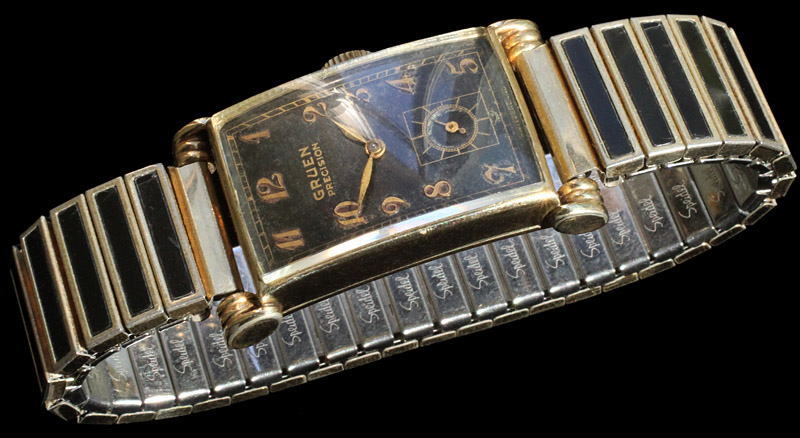

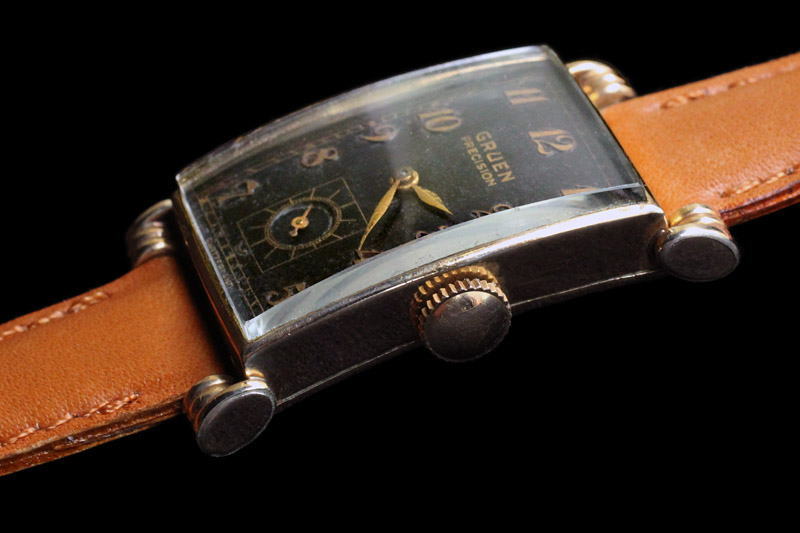



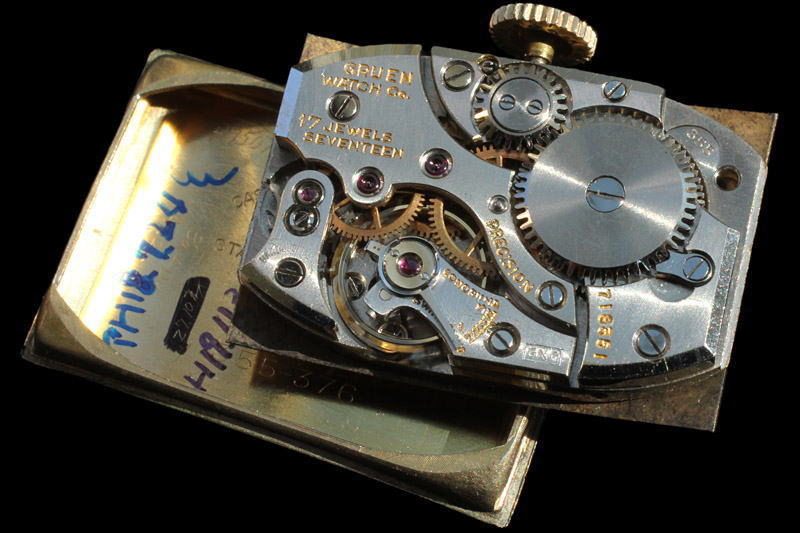

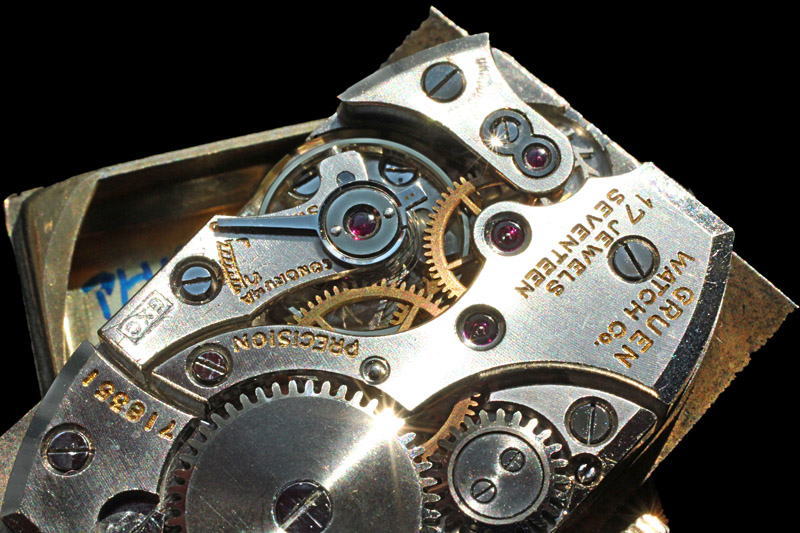
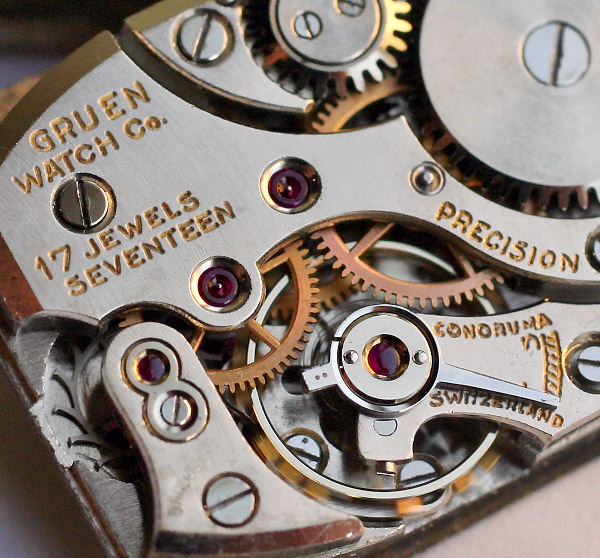

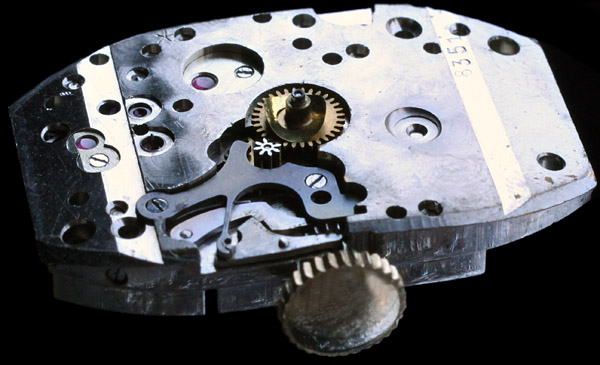
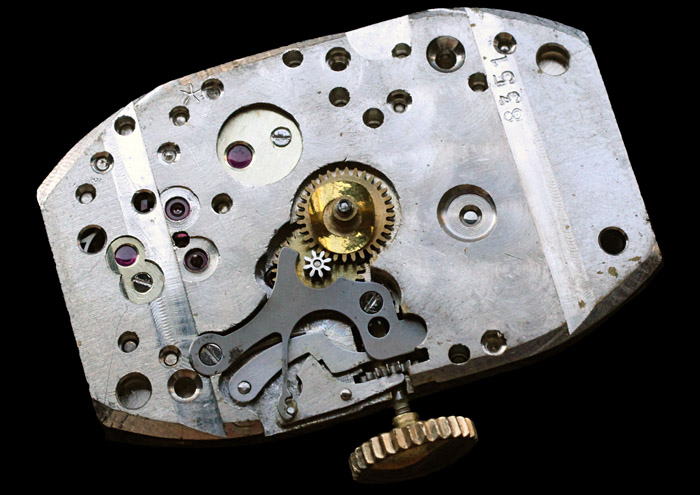



Gruen "Precision" - an Art-Deco style dress watch with a black
dial
This is a wristwatch made by Gruen, a U. S. watch manufacturer, around
1940. Though it is originally a man's watch, it could be used by a lady
due to its smaller size compared with watches nowadays. This watch is in
a good mechanical condition, running as it should with no problem.

The Gruen Watch Company was established by Dietrich Gruen/Grün (1847 -
1911) in the United States. Following his brothers, Dietrich emigrated
to the U. S. in 1867, when he was twenty. A diligent and excellent watchmaker,
Dietrich got the patent for his safety pinion in 1874, and established the Columbus Watch Manufacturing Company in Columbus, Ohio, in 1876, the president of which was Dietrich himself.
The U. S. economy being destroyed by the great depression in 1893, his
company went bankrupt. When it was revived under a new name of the New
Columbus Watch Manufacturing Company, Dietrich Gruen declined to work for
the latter and established another watch manufacturer D. Gruen and Son.
It was originally located in Columbus, but was moved to the Time Hill in
Cincinnati. Gruen Watch Company continued business in the U.S. until 1958,
after which they operated a watch factory in Biel, Switzerland until 1977.

The inner works of a watch is called a "movement". The visible
metal outside of a watch is called a "case". This Gruen has a
"rectangular" case.
Because wristwatches evolved from pocket watches, all early wristwatches
had round movements in them. Also wristwatches were worn only by women.
In 1930's, as the number of men who wore wristwatches became bigger, and
rectangular shapes in watches became in fashion, watch manufacturers developed
near-rectangular movements which best suited rectangular watch cases for
men. Gruen's "Quadron" is an earliest example.

This watch, like Quadron watches developped a few years before, has a
tonneau movement, caliber 355c, which fits its rectangular case well. Gruen
caliber 355c is a wind-up movement, not a battery operated quartz. Quartz
watches prevailed only after 1970s. When this watch was made in 1930s,
quartz watches did not exist. All watches were mechanical, driven by springs.
When you put your ear on a quartz watch that has a second hand, you hear
its step motor move the hand in one-second interval. If the quartz watch
does not have a second hand, you hear nothing. If it is an old pocket watch
or an old wristwatch like this one, the watch is mechanical, and you can
hear its inner works ticking away. The sound is small and continuous, as
if a gnome were ringing a small bell continuously.

Mechanical pocket watches and wristwatches of higher quality use ruby in such parts as should not be allowed to become worn. Ruby, a mineral
called corundum, is very hard at nine on Mohs's scale, and as such is used for good mechanical watches. The movement of this watch, Gruen caliber 355c, has seventeen ruby parts in it. You could see only four rubies in the photo above, but thirteen more ruby parts are used in places like the pillar plate under the dial and other places invisible from outside.
When a movement has seventeen jewels (rubies) in it, it is called a "high
jewel" movement, which means the movement has jewels in all the parts
that should not wear. Many Swiss watches contemporary to this one had only
fifteen jewels. Gruen caliber 355c has an extra pair of jewels for its
pallet wheel, making its jewel count an ideal seventeen.

The picture above shows the bridge side (the side you can see when you
open the back of the watch case). You see inscriptions such as the manufacturer's
name "Gruen Watch Company", the grade name "Precision"
which means this movement is a high-jewel one, the number of the jewels
(SEVENTEEN JEWELS), the serial number of this movement (718351). The three-letter
mark "GXC" you see on the balance bridge is the U. S. watch import
code for Gruen. It means Gruen is the importer of this movement to the
U. S. A.
Apart from the "Twenty-One", which are the twenty-one jeweled
movements made in Cincinnati just before they cease operation in the U.
S, Gruen had always imported movements from Switzerland, put them in cases
and timed them in the U. S. This movement, caliber 355c, was made in their
factory in Biel, Switzerland. You can see the caliber name "355"
inscribed near the barrel wheel.
You can see "Conoruma" inscribed on the balance bridge. Conoruma
is an alloy developed by Gruen. Conoruma, like Elinvar (an alloy of iron,
nickel, and chrome), resists temperature change well and is used in balances
and hairsprings.

Gruen was famous for the curved design of its rectangular watches called
"Curvex". Their curvex case fit the curve of your wrist and allows
the watch rest there snugly. This watch's dial does not say "Curvex",
but the curved design of the case is the one characteristic to Gruen.

The dial curves in accordance to the case design. In the calibers 355
and 355c, the bridge side of the movement does not curve as it does in
caliber 311, another caliber of the same strain. The difference between
355 and 355c is that the pillar plate (the plate on which the dial is attached)
of 355c curves, while that of 355 does not.
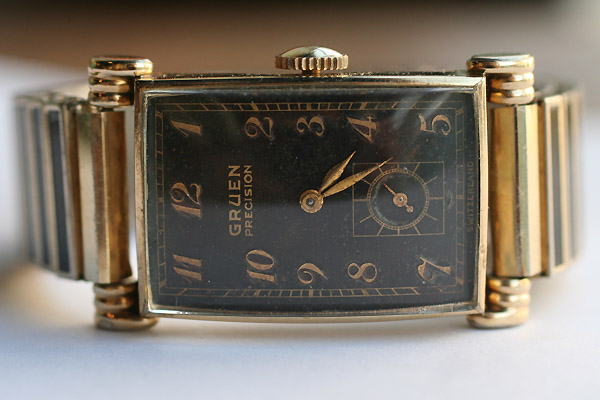
The black dial of this watch has "GRUEN PRECISION" and "SWITZERLAND"
painted in gold color, showing a gorgeous contrast against the black dial.
The numerals that surround the dial are called "indeces". The
indeces of this watch are eleganty italicised "Breguet style"
Arabic numerals. They are of gold color that matches the case, but they
are also matt, reflecting the light softly. Minute graduations is painted
in gold color in the outermost part of the dial.
From 1960s to today, watch dials that have raised logoes and indeces have
such small parts made separately and have them applied on them. But the
Breguet numerals of this watch are engraved. In 1930s and 40s, watches
were very expensive handmade artifacts. In 1960s and 70s, they were factory-made
"run of the mill" products. You could see the difference also
in such small parts.
In the pictures you could see some discoloration on the dial. Because
the pictures are much bigger compared with the actual watch, the discoloration
is discerned easily. When you personally see the watch with your naked
eyes, I don't think you mind the aged expression of the dial.
While present-day watches have their second hand installed at the center
of the dial, old watches, until 1950s, had an indial for a small second
hand at six o'clock. Because installing the second hand at the center of
a watch was technically difficult, such watches prevailed only in 1960s
and after. In 1930s and 40s, almost all watches, including this one, had
a small second hand in a small indial at six.
The hour and minute hands of this watch are original to this watch. They
are gold colored. Their shape is called the "leaf" type, whose
elegantly curved shape is very suitable to a vintage watch.
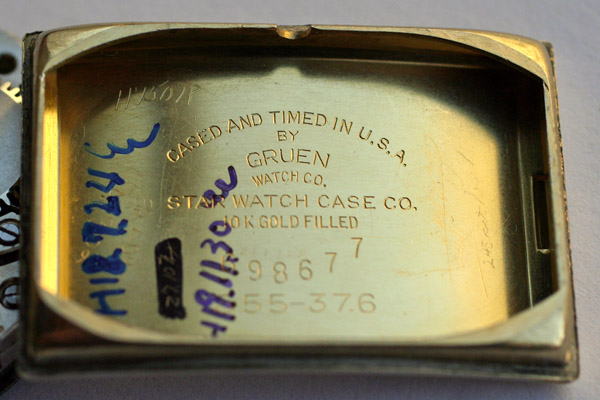
The case of this watch is 10 karat gold filled. Gold fill is a plating technique of high quality. cementing a thin (but tens of
times thicker than electroplate) gold plate on base metal by high temperature
and pressure. Gruen's gold fill is famous for its thickness. In fact they
called their gold fill "14K gold reinforced with metal" etc in
their earlier models.
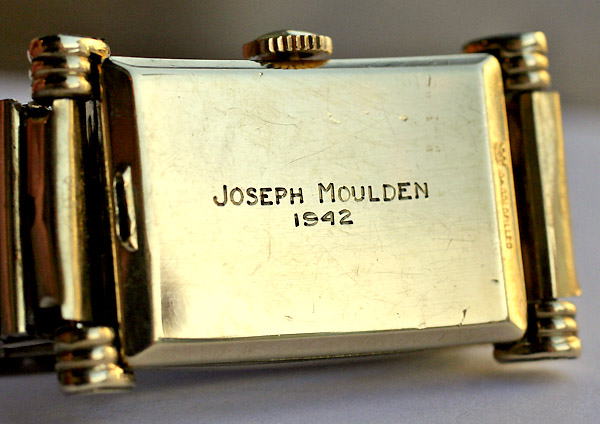
When Japan attacked Pearl Harbor on December 8, 1941 and World War II
began, the U. S. government ordered domestic watch manufacturers (Elgin,
Hamilton, and Waltham that made their watch movements in their domestic
factories) to make only military watches. Therefore these three manufacturers
were not able to make watches for the general consumers. Bulova was able
to make consumer watches because they imported movements from Switzerland.
Gruen imported movements from Switzerland, too, but they stopped making
consumer watches during the war, making military precision instruments
at the Time Hill (their headquarter and factory) in Cincinnati. This caused
the scarcity of Gruen watches made and imported during the war.
This watch has the year 1942 engraved on its back. It means this watch
was most probably made in 1941 or before.

The band in the picture above is an expandable one contemporary to this
watch. It is 10 karat rolled gold plate (almost the same as gold filled
but less than 20% gold content) with glossy black acrylic. Its back is
stainless steel. The entire length of the watch and band, measured when
the band is not stretched, is a bit longer than 16 cm.
The band in the picture above is original to the watch, but "original"
in this case only means that the original owner of this watch personally
liked this band and chose it for this watch. Watch manufacturers don't
make bands. This one is a product of Speidel, a U. S. manufacturer specializing
in making generic bands. So you should choose a band of an appropriate
size and an appropriate material for yourself. The pictures below show
this watch with leather bands on.



A Gruen box contemporary to this watch is available at 50 euros.


Vintage watches are generally sold "as are". But because we
have many old Gruen parts, we can repair your watch if your watch should
be broken in the future.

You could pay by wire transfer. Please feel free to contact us.
SOLD
男性用(男女兼用)腕時計 商品種別表示インデックスに戻る
男性用(男女兼用)腕時計 一覧表示インデックスに戻る
腕時計 商品種別表示インデックスに移動する
時計と関連用品 商品種別表示インデックスに移動する
アンティークアナスタシア ウェブサイトのトップ・ページに移動する
Ἀναστασία ἡ Οὐτοπία τῶν αἰλούρων ANASTASIA KOBENSIS, ANTIQUARUM RERUM LOCUS NON INVENIENDUS